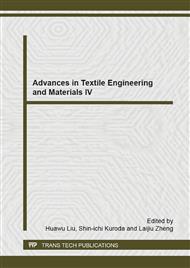p.3
p.9
p.13
p.17
p.21
p.26
p.31
p.36
Adhesive Content Influence on Antimicrobial Properties of Pineapple Leaf Fiber
Abstract:
This study tests the antimicrobial properties of pineapple leaf fiber. Scanning electron microscopy (SEM), infrared analysis (IR) and other test methods were used to examine the microcosmic morphologies of pineapple leaf fiber. As the pineapple leaf fiber adhesive content reduce fiber antibacterial. Adhesive content 54% of fiber to escherichia coli and staphylococcus aureus antibacterial value is maximum. With further reduce fiber adhesive content, fiber antimicrobial declined obviously. The results indicate that the anaerobic bacteria can’t survive in the inside of pineapple leaf fiber where exist a large specific surface-area, lots of holes and Voids, and much oxygen. Pineapple leaf fiber contains a lot of phenols and their derivatives which are effective natural bacteria resistant materials and inhibit the metabolism and physiology of bacillus and other microorganism,break the structure of germ, and repress the generation of bacillus until the death of germ.Moreover, the existence of a small amount of cannabinol is adequate to kill the microorganisms.
Info:
Periodical:
Pages:
3-8
Citation:
Online since:
October 2014
Authors:
Keywords:
Price:
Сopyright:
© 2014 Trans Tech Publications Ltd. All Rights Reserved
Share:
Citation:


